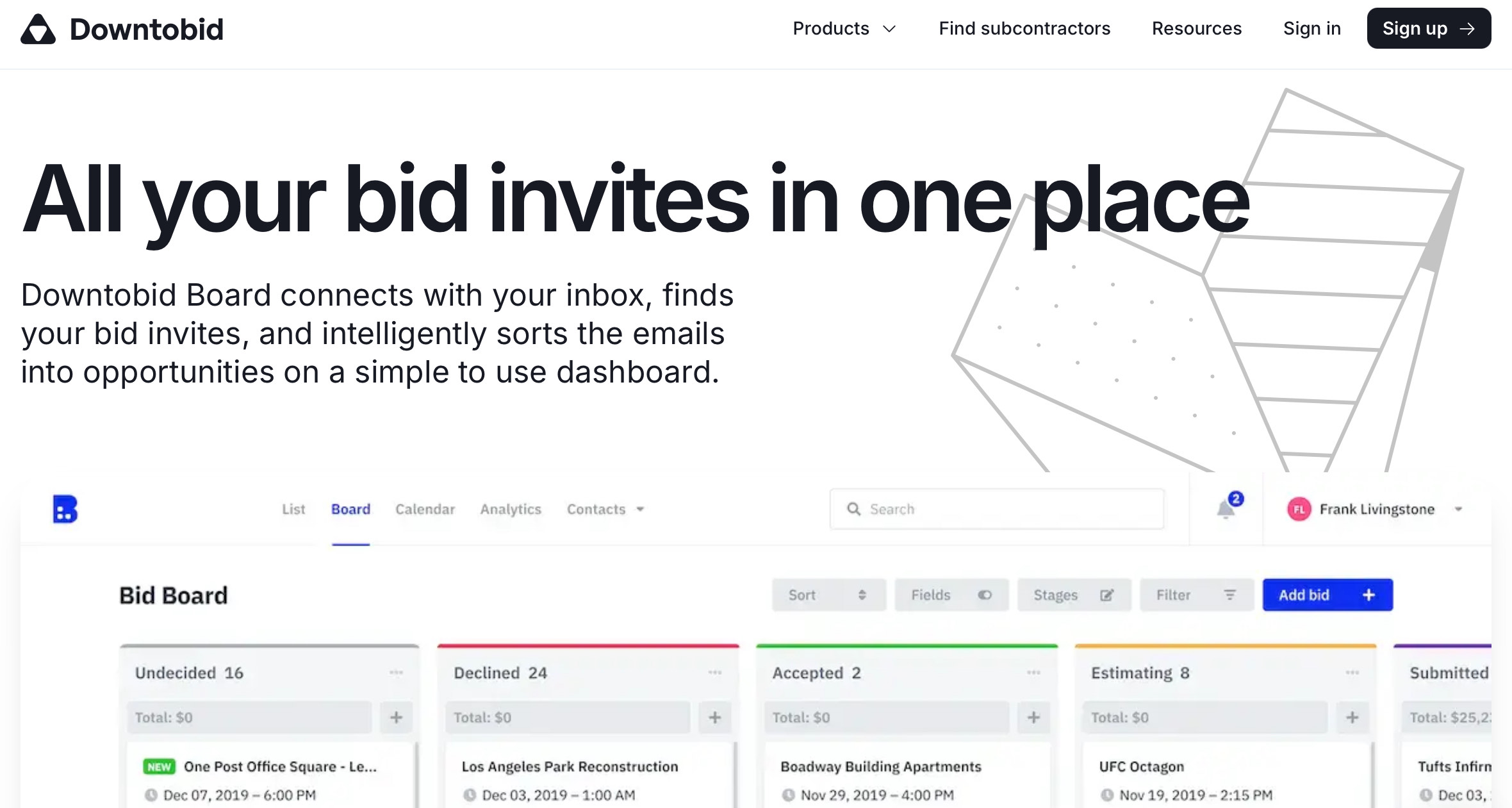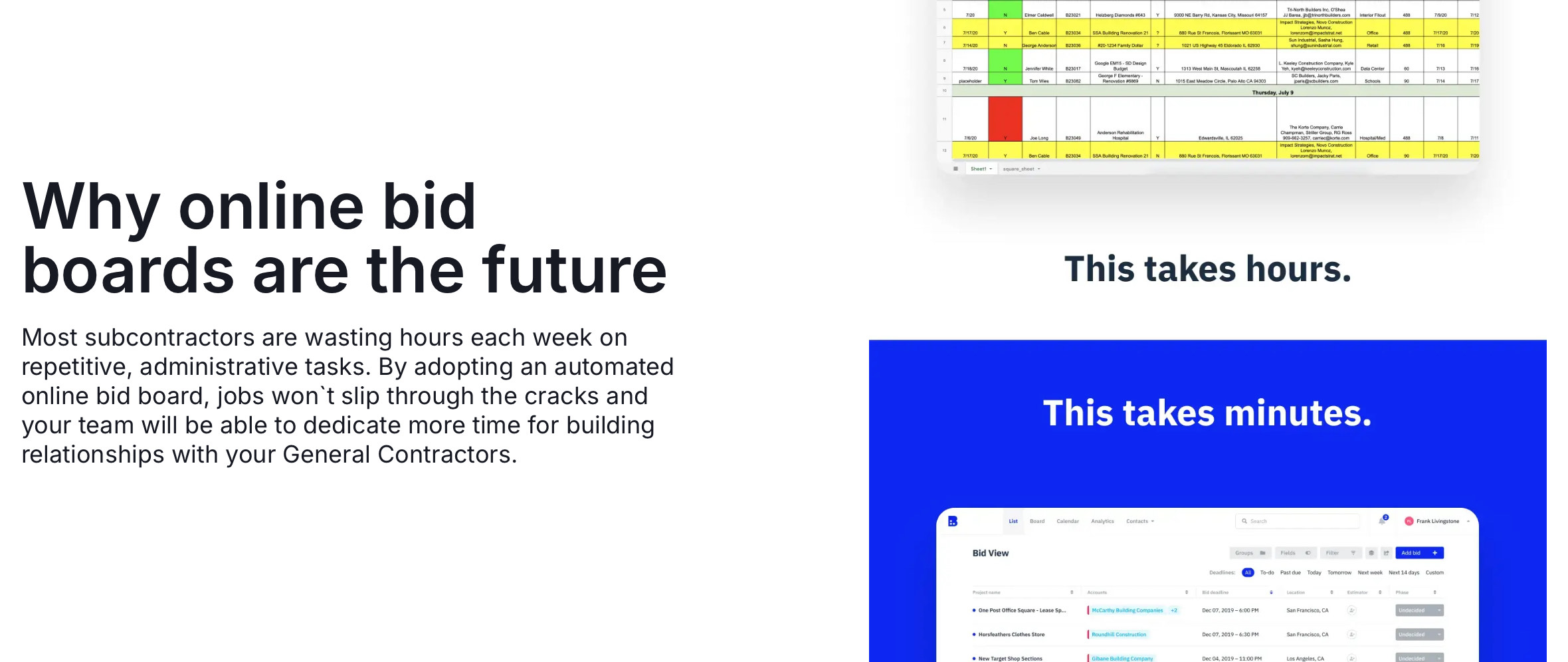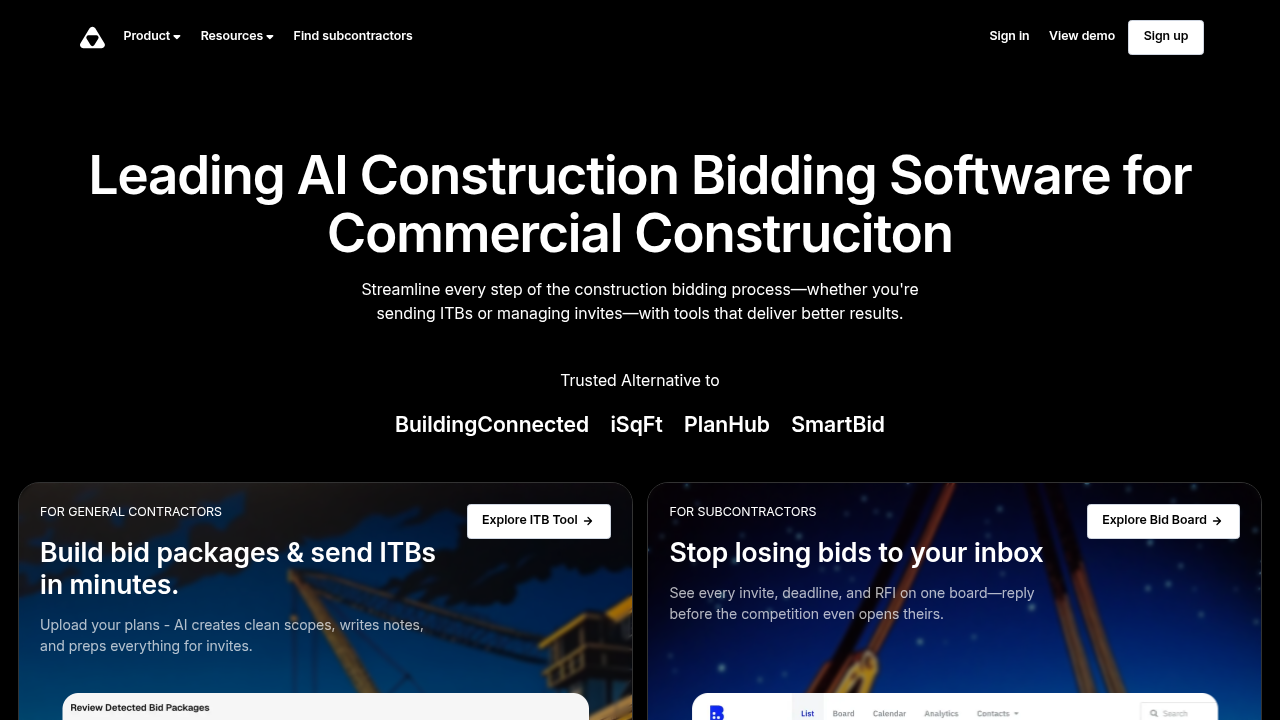You've probably been creating your bid forms the same way for years, but those outdated templates might be costing you projects. Everyone knows that sloppy paperwork can make even the best contractor look unprofessional, and in 2025, clients expect bid forms that are clean, detailed, and easy to understand.
In this article, we’ll walk you through how to format a clear, professional bid form that lays the foundation for winning more construction projects and protecting your margins.
TLDR:
-
Professional bid forms can increase win rates and require 6 key components: project info, costs, timeline, payment terms, change procedures, and warranties
-
Excel templates automate calculations and reduce errors, while PDF forms maintain professional formatting across all devices
-
Common mistakes like incomplete project info and outdated material prices cost contractors projects and profit margins
-
Downtobid's AI-powered system eliminates manual bid tracking, automatically organizing invitations, and saving contractors 15+ hours weekly
-
Modern bid management systems double response rates through automated deadline tracking and team collaboration features
What Are Bid Forms in Construction
Bid forms are standardized documents that contractors use to submit proposals for construction projects. They serve as the foundation for all project communications between contractors and clients.
These forms capture everything from basic project information to detailed cost breakdowns. They show that you understand the project requirements and can deliver quality work within budget.
Construction bid forms help establish clear expectations and provide documentation that supports resolving disputes if they arise.
This prevents misunderstandings that could lead to disputes later.
The construction industry relies heavily on these documents because they create consistency across different projects and contractors. General contractors can easily compare multiple bids when they're all formatted similarly.
Most successful contractors use standardized templates that they customize for each project. This approach saves time while making sure they don't miss important information.

Types of Bid Forms for Construction Projects
Construction projects require different types of bid forms depending on their scope and complexity. Understanding these variations helps you choose the right format for each situation.
-
Invitation to Bid (ITB) Forms are used when general contractors solicit bids from subcontractors. These forms outline project specifications and requirements that subs must cover in their responses.
-
Bid Proposal Templates are detailed documents that contractors submit to clients. They include full project descriptions, cost estimates, and terms of service. See this bid proposal example.
Key Components of Construction Bid Forms
Every effective construction bid form must include specific components to be complete and legally sound. Missing any of these elements can disqualify your bid or create problems later.
-
Project Information Section: include the client's name, project location, and detailed scope of work. Be specific about what you will and won't do to avoid scope creep.
-
Contractor Details: include your business name, license number, insurance information, and contact details. This shows your credibility and legal standing.
-
Cost Breakdown: list separate materials, labor, equipment, and overhead costs. Clients appreciate transparency in pricing.
-
Timeline and Schedule: this section lists when work will start and finish. Include major milestones and any factors that could affect the schedule.
-
Payment Terms: specify when and how you expect to be paid. Include details about progress payments, final payment, and any penalties for late payment.
-
Change Order Procedures: explain how additional work will be handled. This protects you when clients request modifications to the original scope.
-
Warranty Information: describe what you guarantee and for how long.
| Component | Purpose | Key Details | | --- | --- | --- | | Project Info | Defines scope | Location, specifications, exclusions | | Contractor Details | Shows credibility | License, insurance, contact info | | Cost Breakdown | Shows pricing | Materials, labor, overhead, profit | | Timeline | Sets expectations | Start date, milestones, completion | | Payment Terms | Protects cash flow | Schedule, methods, penalties |
The bid board approach helps organize all these components systematically. You can track which sections are complete and which need attention.
TemplateLab's construction proposal guide shows that incomplete forms are the fastest way to lose credibility with potential clients.
Step-by-Step Guide to Complete a Construction Bid Form
Completing a construction bid form systematically helps you avoid missing important information that could affect your project's success. Follow this proven process for consistent results:
-
Review Project Documents Thoroughly: Read all specifications, plans, and requirements before starting your bid form. Take notes on special requirements or potential challenges that might affect your pricing.
-
Calculate Material Costs: List all materials needed and get current pricing from your suppliers. Include delivery costs and add a buffer for price fluctuations between bid submission and project start.
-
Estimate Labor Requirements: Calculate the hours needed for each phase of work. Consider your crew's skill level and productivity rates. Don't forget to include time for setup, cleanup, and potential weather delays. Learn more on how to calculate labor costs.
-
Calculate Overhead and Profit: Add your standard overhead percentage to cover business expenses. Include a reasonable profit margin that reflects the project's risk level and your expertise.
-
Review and Double-Check Everything: Verify all calculations and make sure you've covered every requirement in the project specifications. Have someone else review your bid for errors or omissions.
Downtobid's bid board process can help organize these steps and make sure nothing falls through the cracks.

Common Mistakes to Avoid When Creating Bid Forms
Even experienced contractors make mistakes that can cost them projects. Learning from these common errors helps you create more competitive and accurate bids.
-
Incomplete Project Information
-
Underestimating Labor Costs
-
Forgetting to include Permit and Inspection Fees
-
Using Outdated Material Prices
-
Missing Deadline Requirements
-
Unclear Change Order Procedures
-
Insufficient Insurance Coverage
Digital Project Manager's construction management insights show how systematic approaches reduce these common errors.
Downtobid's Modern Approach to Bid Management
Modern bid management systems eliminate much of the manual work that slows down the bidding process. Downtobid changes how contractors handle bid forms by automatically pulling invitation emails from your inbox. No more manual forwarding or data entry. The system organizes everything by project and shows important deadlines.
The automated bid parsing feature extracts key project details from invitation documents. This AI-powered feature saves hours of manual review and makes sure you don't miss critical requirements.
Instead of static PDF forms, you get an interactive bid board that tracks all your opportunities in one place. You can see which bids are due soon, which ones need attention, and which team members are working on what.

The system automatically syncs deadlines to your calendar and sends reminders. No more "sorry, just saw this" responses that damage your reputation with general contractors.
Built-in analytics show your win rates by general contractor and help identify which types of projects are most profitable for your business. This data-driven approach improves your bidding strategy over time.
Team collaboration features make sure everyone works with the latest project information. All communications and documents stay attached to each project, eliminating confusion from scattered email threads.
The network effect means you get invited to more relevant projects automatically. When general contractors use Downtobid to send invitations, qualified subcontractors are matched by trade and location.
Contractorsreport saving 15+ hours per week and nearly double their bid response rates using these modern tools.

WebsitePlanet's construction software review also shows how automation is becoming important for competitive contractors.
FAQ
What's the most common mistake that disqualifies construction bids?
Incomplete project information is the most frequent disqualifying mistake, where contractors fail to cover all project requirements or specifications outlined in the invitation to bid. Even small errors can raise red flags for clients and suggest poor attention to detail.
How long should I spend reviewing project documents before completing my bid form?
Thoroughly review all specifications, plans, and requirements before starting your calculations. This upfront time investment prevents costly errors, makes sure you understand the full scope and cover every project requirement in your bid.
When should I consider switching from manual bid forms to automated systems?
Consider upgrading when you're spending more than an hour per week on bid-related administrative tasks, missing deadlines due to poor organization, or struggling to track multiple opportunities simultaneously. Automated systems reduce manual errors and let your team focus on pricing strategy instead of paperwork.
Final thoughts on creating professional construction bid forms
Modern construction demands bid forms that actually work for your business, not against it. The contractors winning more projects have moved beyond static templates to systems that handle the tedious work automatically.
With Downtobid’s bid-board, you can centralize all your invitations, track deadlines effortlessly, and respond faster, without drowning in spreadsheets or email chains. Your bid forms should showcase your professionalism while saving you time on every project. Focus on the details that matter most to clients, and let us handle the rest.